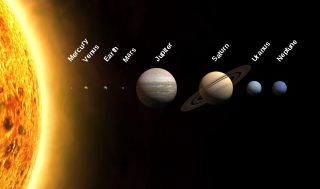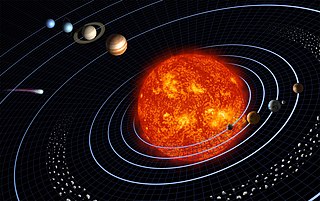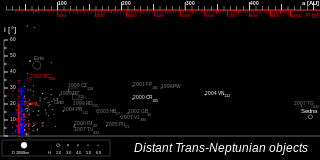This page is based on this
Wikipedia article Text is available under the
CC BY-SA 4.0 license; additional terms may apply.
Images, videos and audio are available under their respective licenses.

The Oort cloud, named after the Dutch astronomer Jan Oort, sometimes called the Öpik–Oort cloud, is a hypothetical cloud of predominantly icy planetesimals proposed to surround the Sun at distances ranging from 2,000 to 200,000 AU. It is divided into two regions: a disc-shaped inner Oort cloud and a spherical outer Oort cloud. Both regions lie beyond the heliosphere and in interstellar space. The Kuiper belt and the scattered disc, the other two reservoirs of trans-Neptunian objects, are less than one thousandth as far from the Sun as the Oort cloud.

The Solar System is the gravitationally bound planetary system of the Sun and the objects that orbit it, either directly or indirectly. Of the objects that orbit the Sun directly, the largest are the eight planets, with the remainder being smaller objects, such as the five dwarf planets and small Solar System bodies. Of the objects that orbit the Sun indirectly—the moons—two are larger than the smallest planet, Mercury.

The asteroid belt is the circumstellar disc in the Solar System located roughly between the orbits of the planets Mars and Jupiter. It is occupied by numerous irregularly shaped bodies called asteroids or minor planets. The asteroid belt is also termed the main asteroid belt or main belt to distinguish it from other asteroid populations in the Solar System such as near-Earth asteroids and trojan asteroids. About half the mass of the belt is contained in the four largest asteroids: Ceres, Vesta, Pallas, and Hygiea. The total mass of the asteroid belt is approximately 4% that of the Moon, or 22% that of Pluto, and roughly twice that of Pluto's moon Charon.

In orbital mechanics and aerospace engineering, a gravitational slingshot, gravity assist maneuver, or swing-by is the use of the relative movement and gravity of a planet or other astronomical object to alter the path and speed of a spacecraft, typically to save propellant and reduce expense.

In the Solar System, a planet is said to be inferior or interior with respect to another planet if its orbit lies inside the other planet's orbit around the Sun. In this situation, the latter planet is said to be superior to the former. In the reference frame of the Earth, in which the terms were originally used, the inferior planets are Mercury and Venus, while the superior planets are Mars, Jupiter, Saturn, Uranus and Neptune. Dwarf planets like Ceres or Pluto and most asteroids are 'superior' in the sense that they almost all orbit outside the orbit of Earth.

The Amor asteroids are a group of near-Earth asteroids named after the archetype object 1221 Amor. The orbital perihelion of these objects is close to, but greater than, the orbital aphelion of Earth, with most Amors crossing the orbit of Mars. The Amor asteroid 433 Eros was the first asteroid to be orbited and landed upon by a robotic space probe.

Detached objects are a dynamical class of minor planets in the outer reaches of the Solar System and belong to the broader family of trans-Neptunian objects (TNOs). These objects have orbits whose points of closest approach to the Sun (perihelion) are sufficiently distant from the gravitational influence of Neptune that they are only moderately affected by Neptune and the other known planets: this makes them appear to be "detached" from the Solar System.
A Bishop Ring is a type of hypothetical rotating space habitat originally proposed in 1997 by Forrest Bishop of the Institute of Atomic-Scale Engineering. The concept is a smaller scale version of the Banks Orbital, which itself is a smaller version of the Ringworld. Like other space habitat designs, the Bishop Ring would spin to produce artificial gravity by way of centrifugal force. The design differs from the classical designs produced in the 1970s by Gerard K. O'Neill and NASA in that it would use carbon nanotubes instead of steel, allowing the habitat to be built much larger. In the original proposal, the habitat would be approximately 1,000 km (620 mi) in radius and 500 km (310 mi) in width, containing 3 million square kilometers of living space, comparable to the area of Argentina or India.

Kepler-11c is an exoplanet discovered in the orbit of the Sun-like star Kepler-11 by the Kepler spacecraft, a NASA telescope aiming to discover Earth-like planets. It is the second planet from its star, and is most likely a water planet with a thin hydrogen–helium atmosphere. Kepler-11c orbits Kepler-11 every 10 days, and has an estimated density twice that of pure water. It is estimated to have a mass thirteen times that of Earth and a radius three times that of Earth. Kepler-11c and its five sister planets form the first discovered system with more than three transiting planets. The Kepler-11 system also holds the record of being the most compact and the flattest system discovered. Kepler-11c and the other Kepler-11 planets were announced to the public on February 2, 2011, and was published in Nature a day later.
Kepler-36 is a star in the constellation of Cygnus with two known planets. It has an anomalously large radius, meaning that it is a subgiant.

Kepler-61b is a super-Earth exoplanet orbiting within parts of the habitable zone of the K-type main-sequence star Kepler-61. It is located about 1,100 light-years from Earth in the constellation of Cygnus. It was discovered in 2013 using the transit method, in which the dimming effect that a planet causes as it crosses in front of its star is measured, by NASA's Kepler spacecraft.
K2-148b is a confirmed Super-Earth, probably rocky, closely orbiting a small orange dwarf star. It is the innermost of three Super-Earths around the star K2-148, which is in a wide binary pair with the M0.5V red dwarf EPIC 220194953. K2-148b is the smallest planet of the system, at about a third larger than Earth, and could be terrestrial in nature. However, the three planets do not exhibit significant transit timing variations, implying that they could have relatively low masses. The planet was validated in early 2018 by Hirano et al. and is too hot for known life.













